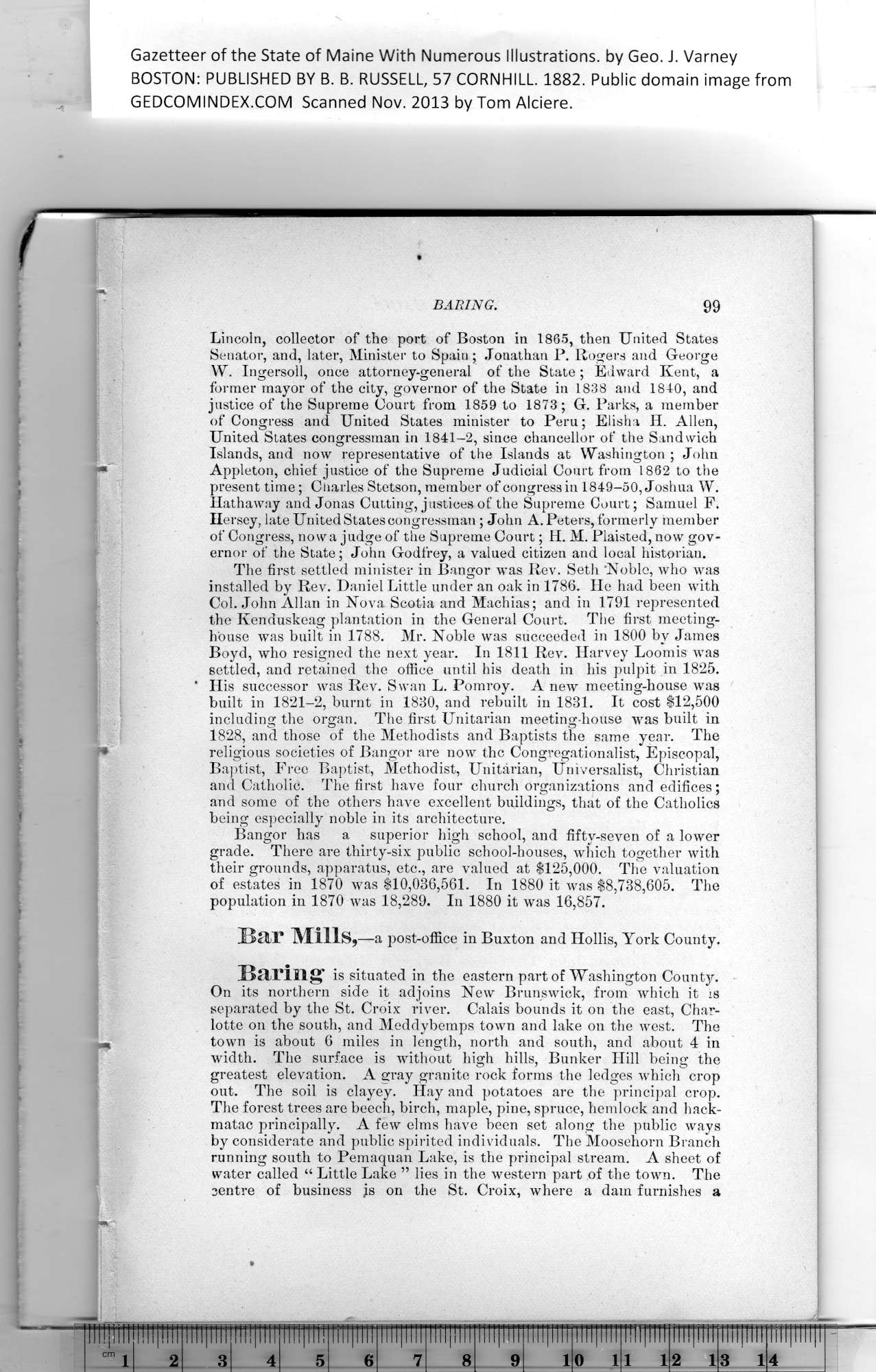|
Gazetteer of the State of Maine With Numerous Illustrations, by Geo. J. Varney
BOSTON: PUBLISHED BY B. B. RUSSELL, 57 CORNHILL. 1882. Public domain image from
BARING. 99
Lincoln, collector of the port of Boston in 1865, then United States
Senator, and, later, Minister to Spain; Jonathan P. Rogers and George
W. Ingersoll, once attorney-general of the State; Edward Kent, a
former mayor of the city, governor of the State in 1838 and 1840, and
justice of the Supreme Court from 1859 to 1873; G. Parks, a member
of Congress and United States minister to Peru; Elisha H. Allen,
United States congressman in 1841-2, since chancellor of the Sandwich
Islands, and now representative of the Islands at Washington ; John
Appleton, chief justice of the Supreme Judicial Court from 1862 to the
present time; Cliarles Stetson, member of congress in 1849-50, Joshua W.
Hathaway and Jonas Cutting, justices of the Supreme Court; Samuel F.
Hersey, late United States congressman ; John A. Peters, formerly member
of Congress, now a judge of the Supreme Court; H. M. Plaisted, now gov-
ernor of the State; John Godfrey, a valued citizen and local historian.
The first settled minister in Bangor was Rev. Seth Noble, who was
installed by Rev. Daniel Little under an oak in 1786. He had been with
Col. John Allan in Nova Scotia and Machias; and in 1791 represented
the Kenduskeag plantation in the General Court. The first meeting-
house was built in 1788. Mr. Noble was succeeded in 1800 by James
Boyd, who resigned the next year. In 1811 Rev. Harvey Loomis was
settled, and retained the office until his death in his pulpit in 1825.
His successor was Rev. Swan L. Pomroy. A new meeting-house was
built in 1821-2, burnt in 1830, and rebuilt in 1831. It cost $12,500
including the organ. The first Unitarian meeting house was built in
1828, and those of the Methodists and Baptists the same year. The
religious societies of Bangor are now the Congregationalist, Episcopal,
Baptist, Free Baptist, Methodist, Unitarian, Universalist, Christian
and Catholic. The first have four church organizations and edifices;
and some of the others have excellent buildings, that of the Catholics
being especially noble in its architecture.
Bangor has a superior high school, and fifty-seven of a lower
grade. There are thirty-six public scliool-houses, which together with
their grounds, apparatus, etc., are valued at $125,000. The valuation
of estates in 1870 was $10,036,561. In 1880 it was $8,738,605. The
population in 1870 was 18,289. In 1880 it was 16,857.
Bar Mills,-a post-office in Buxton and Hollis, York County.
Baring* is situated in the eastern part of Washington County.
On its northern side it adjoins New Brunswick, from which it is
separated by the St. Croix river. Calais bounds it on the east, Char-
lotte on the south, and Meddybemps town and lake on the west. The
town is about 6 miles in length, north and south, and about 4 in
width. The surface is without high hills, Bunker Hill being the
greatest elevation. A gray granite rock forms the ledges which crop
out. The soil is clayey. Hay and potatoes are the principal crop.
The forest trees are beech, birch, maple, pine, spruce, hemlock and hack-
matac principally. A few elms have been set along the public ways
by considerate and public spirited individuals. The Moosehorn Branch
running south to Pemaquan Lake, is tbe principal stream. A sheet of
water called “ Little Lake ” lies in the western part of the town. The
centre of business js on the St. Croix, where a dam furnishes a
PREVIOUS PAGE ... NEXT PAGE
This page was written in HTML using a program written in Python 3.2
|
